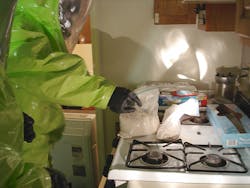Hazmat Studies: The Dangers of Synthetic Opioids
Emergency responders have been dealing with hazardous materials and terrorist incidents for over 30 years now. We have reached a level of competence to deal with most of these hazards. However, a new type of hazardous material has surfaced as a result of the opioid epidemic across the United States and other parts of the world.
Fentanyl is an illicit drug that, even in very small quantities, is much more toxic to emergency responders than other hazardous materials normally encountered. First responders who are involved in some form of response to drug overdoses, clandestine drug labs and other occupancies where drugs are not routinely expected to be found are at a high risk of exposure. There are no placards or labels, no MSDS sheets, no occupancy or location expectations; the only tool to recognize their presence is an awareness of the hazards of fentanyl and related illicit drugs.
In the last year, U.S. law enforcement personnel—including SWAT team members, narcotics officers and police dogs—have been exposed to fentanyl and related compounds, resulting in medical treatment. The purpose of this article is to alert responders to the dangers presented by these materials and to underscore the need for training all personnel to deal with these incidents safely.
Medical uses
Fentanyls are extensively used for anesthesia and analgesia. In his book Drugs in Society: Causes, Concepts and Control, Michael Lyman notes that Duragesic, for example, is a fentanyl transdermal patch used in chronic pain management, and Actiq is a solid formulation of fentanyl citrate on a stick that dissolves slowly in the mouth for transmucosal absorption. Actiq is intended for opiate-tolerant individuals and is effective in treating breakthrough pain in cancer patients. Carfentanil (Wildnil) is an analogue of fentanyl with an analgesic potency 10,000 times that of morphine and is used in veterinary practice.
Illicit uses
The U.S. Drug Enforcement Agency (DEA) indicates that fentanyl is abused for its intense euphoric effects, and can serve as a substitute for heroin in opioid-dependent individuals. However, fentanyl is a very dangerous substitute for heroin because it is 30 to 50 times more potent than heroin, and results in frequent overdoses that can lead to respiratory depression and death.
Fentanyls are most commonly used by intravenous administration, but like heroin, they may also be smoked or snorted. As reported in DEA’s fentanyl resource section, abuse of fentanyls can be through fentanyl patches, oral transmucosal lozenges or injectables.
The earliest DEA record of fentanyl abuse is reported to be the mid-1970s. More recently, abuse of fentanyl and other opioids has reached epidemic proportions across the U.S. As listed in multi-state death reports compiled by DEA, fentanyl-related overdose deaths jumped from around 550 in 2013 to over 2,000 in 2014 and again in 2015. This abuse has only increased into 2016 and 2017.
DEA’s fentanyl resource section cited the Florida Department of Law Enforcement Medical Examiners Annual Report to offer a look at the epidemic in that state. The report noted that fentanyl was identified in 251 deceased persons in Florida in 2012, a number that increased by nearly 263 percent—to 911—in 2015. Of the identified 911 decedents in 2015, fentanyl was the cause of death in 705 of those persons (77.4 percent), a 418 percent increase from 2012.
Per DEA, licit fentanyl is diverted via theft, fraudulent prescriptions and illicit distribution by patients, physicians and pharmacists. Further, illicitly manufactured fentanyl is chiefly responsible for the current domestic crisis. The guide states: “According to the National Forensic Laboratory Information System (NFLIS), which does not distinguish between pharmaceutical and illicitly manufactured fentanyl, there were nearly 5,400 reports of fentanyl in 2014 and more than 14,600 in 2015 by federal, state and local forensic laboratories in the United States. In the first six months of 2016, more than 13,500 fentanyl reports were identified by forensic laboratories.”
DEA’s fentanyl information guide describes a significant outbreak of fentanyl overdoses and deaths from April 2005 to March 2007. Specifically, the Centers for Disease Control and Prevention (CDC)/DEA surveillance system reported 1,013 confirmed non-pharmaceutical fentanyl-related deaths. Most of these deaths occurred in Delaware, Illinois, Maryland, Michigan, Missouri, New Jersey and Pennsylvania. “Consequently, DEA immediately undertook the development of regulations to control the precursor chemicals used by the clandestine laboratories to illicitly manufacture fentanyl. In 2007, DEA published an Interim Final Rule to designate N-phenethyl-4-piperidone (NPP), a precursor to fentanyl, as a List 1 chemical. In 2010, DEA completed a scheduling action of designating another chemical precursor, 4-anilino-N-phenethyl-4-piperidine (ANPP), as a Schedule II immediate precursor. After the control of ANPP, the number of fentanyl-related deaths declined until 2013.”
DEA suspects the source of fentanyl is Mexican drug trafficking organizations, and intelligence has indicated that precursor chemicals have originated from Mexico, Germany, Japan and China.
Nationwide alert
In March 2015, DEA Administrator Michele M. Leonhart issued a nationwide alert to all U.S. law enforcement agencies about the dangers of fentanyl and fentanyl analogues/compounds.
The report explained that because of its high toxicity, fentanyl is a dangerous risk to all emergency responders who may come in contact with it, and that there has been a significant increase in the number of fentanyl-related incidents resulting in victims from overdose and exposures to responders. “According to the NFLIS, state and local labs reported 3,344 fentanyl submissions in 2014, up from 942 in 2013. In addition, DEA had identified 15 other fentanyl-related compounds.” DEA warned that fentanyl can be absorbed through the skin and accidental inhalation, and that doses as small as 0.25 mg can be fatal.
A key takeaway from the report is that all emergency responders can be at risk if they come in contact with fentanyl. During responses to drug overdoses, first responders’ initial thought is naturally focused on the patient. However, fire and EMS personnel must first consider scene safety, which includes the possible presence of fentanyl. Further, law enforcement personnel must be aware of the risk of exposure to fentanyl during routine interactions or inspections, watching for powders on skin and clothing during operations.
Responder considerations
Law enforcement personnel and drug-sniffing dogs are at risk from exposure to synthetic opioids, as fentanyl has been found in busts involving heroin, morphine, oxycodone and hydrocodone. It has also been found in cocaine and synthetic marijuana, aka “spice.” First responders must be aware of the dangers, as a chemical the size of a couple of grains of salt can kill an officer in under 3 minutes.
In August 2015, two New Jersey officers were exposed to fentanyl powder when sealing a bag of confiscated narcotics. Detective E. Price of the Atlantic County Taskforce said in a DEA Officer Safety Alert video, “I felt like my body was shutting down. I thought that was it. I thought I was dying.”
Then in September 2016, 11 Connecticut police officers went to the hospital after suffering from airborne exposure to fentanyl. In a search warrant that netted 50,000 bags of heroin, the SWAT team used flash grenades when gaining entry. This may have aerosolized the powder. The resulting symptoms included lightheadedness, nausea, sore throats, headaches and vomiting. All the officers were treated and released.
Further, the fentanyl analogue carfentanil is even considered a weapons-grade chemical. In September 2016, DEA Acting Administrator Chuck Rosenberg called it, “crazy dangerous.” Further, Andrew Weber, former U.S. assistant secretary of defense for nuclear, chemical and biological defense systems, told The Associated Press in November 2016, “Terrorists could acquire it commercially as we have seen drug dealers doing.”
And, in fact, this has already happened in other countries. Specifically, fentanyl analogues such as carfentanil have killed hundreds of people throughout Europe and the former Soviet republics since the most recent resurgence in use began in Estonia in the early 2000s, and novel derivatives continue to appear. One report: According to the Journal of Analytical Toxicology, in 2002, Russian Special Forces deployed carfentanil after a three-day standoff with Chechen terrorists to rescue hostages in a Moscow theater. The British scientists made this determination after testing clothing and urine samples from three survivors.
Protecting personnel
DEA warns law enforcement officers to recognize the dangers of synthetic opioids and prepare to prevent contamination. Law enforcement is advised to be vigilant with any suspected fentanyl-related narcotic with the following tips:
- Exercise extreme caution.
- Don’t collect samples without special training and PPE.
- Do not field test or transport samples to the office, take them directly to testing labs equipped to handle fentanyls.
- Be aware of symptoms of exposure.
- Seek IMMEDIATE medical attention.
- Administer naloxone as directed.
Personnel suspected of potential exposure based on their duties should carry antidotes with them.
These narcotics may look like powered cocaine, heroin, or be cut into them as a filler. Carfentanil may be found in a powder, blotter paper, tablet, patch or spray form.
Immediately call EMS for exposures. In case of inhalation exposure, move the victim to a safe area with fresh air. If exposure is to the skin, wash the area with soap and water. When drugs are ingested by a still-conscious victim, use cool water to rinse out the victim’s eyes and mouth. Do not induce vomiting. Give Naloxone as soon as possible.
In sum
Fentanyl and related opioid illicit drugs have spawned public health emergencies across the United States. Not only are drug users at risk, but those responding to overdoses to render aid or investigate are in danger from these materials. All emergency services should train their personnel for awareness of these drugs and how to recognize when they are present, and how to protect themselves if they do encounter them.
Sidebar: Fentanyl Facts
- Control status: Schedule II substance
- Other name: fentanil
- Drug class: Opioid
- Formula: C22H28N2O
- IUPAC name N-(1-(2-Phenylethyl)-4-piperidinyl)-N-phenylpropanamide
Sidebar: Treating overdoses
According to the National Institutes of Health (NIH), 91 Americans fatally overdose on an opioid drug every day, whether using a prescription analgesic or heroin. Fortunately, there are remedies that can reverse the effects. Specifically, Narcan (naloxone) is an opioid antagonist, meaning that it binds to opioid receptors and can reverse and block the effects of other opioids. According to the NIH, it can very quickly restore normal respiration to a person whose breathing has slowed or stopped as a result of overdosing with heroin or prescription opioid pain medications. Further, the Food and Drug Administration has approved Narcan in three forms: injectable, which requires training to the administer; autoinjectable; and prepackaged nasal spray.
References
Lyman, M. Drugs in Society: Causes, Concepts and Control. Seventh Edition. 2013.
U.S. Drug Enforcement Agency. DEA Issues Nationwide Alert on Fentanyl as Threat to Health and Public Safety. March 18, 2015. dea.gov/divisions/hq/2015/hq031815.shtml.
DEA Diversion Control Division Drug & Chemical Evaluation Section. Fentanyl. December 2016. deadiversion.usdoj.gov/drug_chem_info/fentanyl.pdf.
DEA Officer Safety Alert. Fentanyl: A Real Threat to Law Enforcement. http://tinyurl.com/DEA-roll-call-video.
Associated Press. “11 Connecticut cops sickened during heroin and fentanyl bust.” Sept. 14, 2016. http://tinyurl.com/AP-CT-police.
Riches, et al. “Analysis of Clothing and Urine from Moscow Theatre Siege Casualties Reveals Carfentanil and Remifentanil Use.” Journal of Analytic Toxicology. September 2012 (36), pp. 647–656. http://tinyurl.com/Moscow-Carf.
Associated Press (Kinetz, E. and Satter, R.) “China carfentanil trade thrives as seizures top 400 in US.” Nov. 03, 2016. http://tinyurl.com/china-carfentanil-trade.
KFOR.com. “‘It is crazy dangerous,’ Experts warning about deadly drug cocktail putting public, first responders at risk.” June 22, 2017. http://tinyurl.com/KFOR-crazy-dangerous.
National Institute on Drug Abuse. “Opioid Overdose Reversal with Naloxone (Narcan, Evzio).” September 2016. drugabuse.gov/related-topics/opioid-overdose-reversal-naloxone-narcan-evzio.
About the Author

Robert Burke
Robert Burke, who is a hazardous materials and fire protection consultant and who served as a Firehouse contributing editor, is a Certified Fire Protection Specialist (CFSP), Fire Inspector II, Fire Inspector III, Fire Investigator and Hazardous Materials Specialist. He has served on state and county hazmat teams. Burke is the author of the textbooks "Hazardous Materials Chemistry for Emergency Responders," "Counter-Terrorism for Emergency Responders," "Fire Protection: Systems and Response," "Hazmat Teams Across America" and "Hazmatology: The Science of Hazardous Materials."
